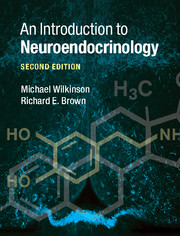Book contents
- Frontmatter
- Dedication
- Contents
- Preface to the second edition
- Acknowledgements
- List of abbreviations
- 1 Classification of chemical messengers
- 2 The endocrine glands and their hormones
- 3 The pituitary gland and its hormones
- 4 The hypothalamic hormones
- 5 Neurotransmitters
- 6 Neurotransmitter and neuropeptide control of hypothalamic, pituitary and other hormones
- 7 Regulation of hormone synthesis, storage, release, transport and deactivation
- 8 Regulation of hormone levels in the bloodstream
- 9 Steroid and thyroid hormone receptors
- 10 Receptors for peptide hormones, neuropeptides and neurotransmitters
- 11 Neuropeptides I: classification, synthesis and co-localization with classical neurotransmitters
- 12 Neuropeptides II: function
- 13 Cytokines and the interaction between the neuroendocrine and immune systems
- 14 Methods for the study of behavioral neuroendocrinology
- 15 An overview of behavioral neuroendocrinology: present, past and future
- Index
- References
7 - Regulation of hormone synthesis, storage, release, transport and deactivation
Published online by Cambridge University Press: 05 June 2015
- Frontmatter
- Dedication
- Contents
- Preface to the second edition
- Acknowledgements
- List of abbreviations
- 1 Classification of chemical messengers
- 2 The endocrine glands and their hormones
- 3 The pituitary gland and its hormones
- 4 The hypothalamic hormones
- 5 Neurotransmitters
- 6 Neurotransmitter and neuropeptide control of hypothalamic, pituitary and other hormones
- 7 Regulation of hormone synthesis, storage, release, transport and deactivation
- 8 Regulation of hormone levels in the bloodstream
- 9 Steroid and thyroid hormone receptors
- 10 Receptors for peptide hormones, neuropeptides and neurotransmitters
- 11 Neuropeptides I: classification, synthesis and co-localization with classical neurotransmitters
- 12 Neuropeptides II: function
- 13 Cytokines and the interaction between the neuroendocrine and immune systems
- 14 Methods for the study of behavioral neuroendocrinology
- 15 An overview of behavioral neuroendocrinology: present, past and future
- Index
- References
Summary
The endocrine system is driven by hormones released into the bloodstream in order to regulate other, distant organs (see Figure 1.3). These hormones are chemical messages that are decoded by specific recognition sites, or receptors, located in the target cells. Hormones are synthesized and stored in endocrine cells and, when required, they are released into the circulatory system. A number of hormones are transported in the bloodstream by carrier proteins. For example, sex hormone binding globulin is specifically responsible for transport of estradiol and testosterone. Other proteins such as albumin are less specific and serve to transport a variety of hormones. Hormone synthesis, storage, release, transport and deactivation occur through a variety of different mechanisms, depending on the chemical structure of the hormone. For example, peptides such as oxytocin are different in almost every respect from steroid hormones like estradiol. For this reason, the first section of this chapter will examine the chemical structure of hormones.
The chemical structure of hormones
In terms of chemical structure, hormones can be divided into three major groups: (1) steroid hormones; (2) amines; and (3) peptide hormones (Table 7.1). Steroid hormones, like estradiol, are different from the other two groups because of their very low solubility in blood. This is because they are essentially hydrocarbons and therefore need a binding protein to carry them in the bloodstream. A further distinction is the mechanism of their synthesis; steroids and amines are produced from precursors (such as cholesterol and tyrosine, respectively) via specific enzymes, whereas peptides are encoded by specific genes (DNA) that transcribe messenger RNA (mRNA) that is then translated into precursor peptides.
7.1.1 Steroid hormones
The steroid hormones are biosynthesized from cholesterol in the adrenal cortex and gonads. Adrenal steroids include cortisol and aldosterone and the gonadal steroids are progesterone, testosterone and estradiol (see Table 7.1). Note that some steroids are also made in the brain, fat tissue and placenta.
- Type
- Chapter
- Information
- An Introduction to Neuroendocrinology , pp. 157 - 169Publisher: Cambridge University PressPrint publication year: 2015
References
- 1
- Cited by



